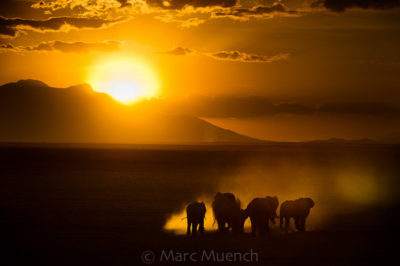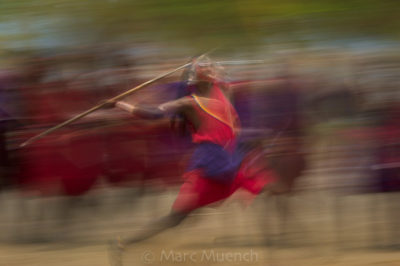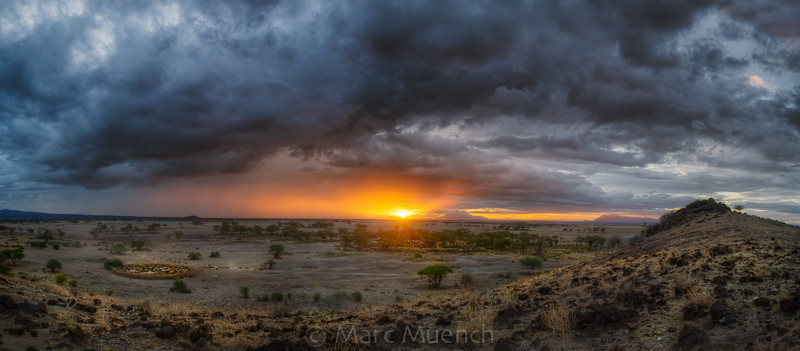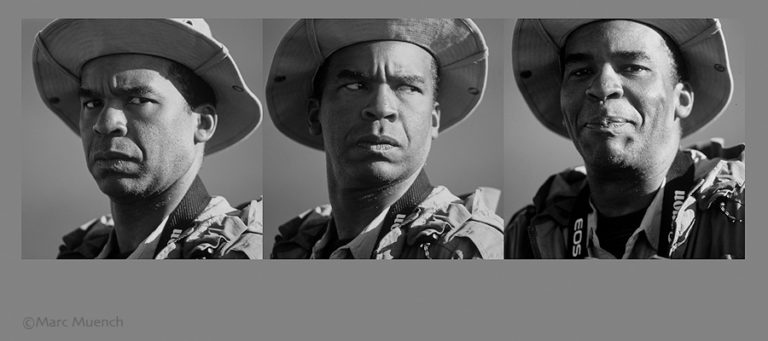
Of all the places I have perceived as perfect in the eyes of a nature photographer, nothing prepared me for the African experience. It was a vortex of landscapes, animals, and cultural encounters. Nowhere else on earth is there such a vast array of these subjects concentrated in such a mild climate. There were few bugs, at least biting ones! The temperature was extremely pleasant, and I have the credentials to say this, after having spent my life in one of the mildest climates of the world, Santa Barbara, California.
The wildlife was omnipresent. During one sunrise shoot, we crept out of the jeeps to the sound of lions roaring just over the hill. All night long we could hear the sound of the hippos milling around in the nearby river. Moments after taking pictures of a very beautiful tree against a painted sky we were off chasing zebras silhouetted against the golden sun. Then a quick ride over a skyline ridge revealed vast herds of Wildebeest grazing on an unusually green plain. While driving from encounter to encounter it’s not hard to notice skeletons scattered about, giving testimony to the reality of the place.

Now that I have talked it up, I must share with you the great anxiety that occurred to me while flying from location to location within this region of Kenya. While in the air, the preserves we were visiting became islands in a vast empire of scattered farms, small towns, and deforestation. The world had discovered just how lovely these areas are and has become bound and determined to utilize the nourishing resources. I can only imagine the pressure each preserve has on it to give in to this insatiable demand. I wrote most of the beginning of this while flying home for more than 30 hours in the sky. Upon my return, when the jet lag had subsided just enough allowing me to find my front door and fetch the mail, I found the latest copy of National Geographic and thumbed through it. There it was, “RIFT in the great valley” a feature story on the very region I had just visited. It was all about the valuable resources and land that were being overrun by an alarming population increase.

First off, let me attempt to add more insight into just how amazing this place is. The combination of wild mammals, landscape, and native peoples did something to my emotions that I was not prepared for. In Alaska, the Philippines, and Indonesia I have witnessed amazing native peoples living off the land in wonderful harmony. In our own southwest, I have witnessed the Navajo and Hopi people live in very harsh conditions as one with the land. Likewise in the interior of Mexico, I have met the same types of people who lived off the land with great dignity and character. All these rather primitive peoples and their lifestyles did not include the ever-present predators, such as the lion, jaguar, hyena, crocodile, and others. The presence of these great creatures along with the massive elephants, hippos, and rhinos, creates a condition that for me is still nearly indescribable. The only description that potentially explains the wilds of Africa is what I learned about the dinosaurs. In those images, there were lush illustrations filled with abundant foliage and wildlife, just what I had seen in Kenya. Just like in the dinosaur age, looming in the background of most of the regions are volcanoes towering up into a totally different climate. The highest and largest is Mt. Kilimanjaro at 19,000 feet. On the last night of the photography workshop part of my trip, just after all our celebratory speaking was over, I peered out from under the canvas tent to notice that the top of Kilimanjaro was not only visible but in the full moon’s light, there was a very fresh and thick layer of snow covering the entire summit from about 14,000 on up. For most of the trip, clouds had obscured the summit leaving my mind to guess just how high up through the clouds it actually sat. To my amazement, 19,000 feet was much higher than I had considered.

It seems now more than ever, change is biting at the heels of Eden and this last, lost land is shrinking faster than ever before in history. From a photographic point of view, the entire region is a set. All one has to do is roam a bit to find a stunning foreground to include in your composition. In this case, a foreground could be a herd of Wildebeest or pride of lions. I am certainly not a wildlife photographer as I have only pursued certain animals briefly when the conditions were perfect. But because the conditions where we went in Africa were nothing but perfect even on a bad day, I am saddened to think that losing something as powerfully influential as this glorious region filled with just the right amount of animals, landscape and culture would be tragic indeed.
I now see why so many who have visited Africa have stayed, started foundations, or become involved in some manner and are preserving its unique qualities. I now understand why so many have fallen in love with this continent.
Life is short, take pictures!

